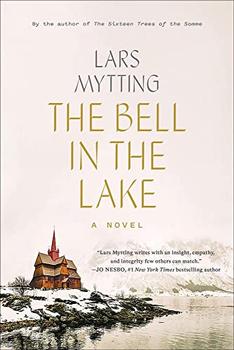Page 1 of 1
There are currently 3 reader reviews for The Bell in the Lake
Write your own review!
 RebeccaR
An Unexpected Wow!
RebeccaR
An Unexpected Wow!
I doubt that this book's cover design or pre-publication descriptions would have caught my eye or enticed me into reading the book. Hmmm, "exquisitely atmospheric" I mumbled to myself. Even as I read the first few pages I wondered if I was going to "get into" this novel. However, I slowly felt myself being pulled into the life of this remote village and starting to silently cheer and quickly read a few more pages every time that Astrid seems determined to change her life. This is exactly why I have loved being a member of BookBrowse for so very many years; I have discovered some incredible books.
THE BELL IN THE LAKE truly transported me back in time to this wooded area of Norway. I also marveled at the author's ability to convey the emotions of Astrid, the lead female character, as well as the emotional conflicts of two competing male characters. At no time did I feel that something was getting lost in the translation or that maybe the English translator had failed to capture whatever it was that had made this book an international bestseller.
This book was an immersive experience. I know it may not be a novel that all of my book-reading friends will necessarily love as much as I did, but perhaps I am as wrong about that as I was with my own first impression.
Margotp
Historical fiction at its best
I absolutely loved this epic tale of three people—a fierce young woman, her local Protestant pastor, and a young German artist and architect student. Set in frigid central Norway, the novel centers around the magical powers of the stave church’s “sister bells‘’ which were donated in the early 1800s in memory of two conjoined twin girls who died at a young age. The plot is rich with detail and imagery. The love triangle is fascinating as is the artistic descriptions and history of the Norwegian stave churches. The first in a trilogy, I cannot wait to get the next one. Definitely needed Kleenex at the end!
Katherine Pond
The Stave Church Represents So Very Much
Received a copy of this book to discuss on BookBrowse. Although the human story revolves around three young people and their interactions, the true story is about tradition and modernity.
One of the characters is Kai Schweigaard, the newly arrived, young, unmarried priest. Kai has been sent to the isolated village of Buntagen, Norway. It is his first assignment and he is eager to make a good impression and rise in the ranks of the Church. He has a fiancee back home and his success will allow him to marry and bring her to his side. The church in which he finds himself is too small for the congregation, is cold and drafty and totally dark and depressing. Indeed, at one of his first services, the snow falls through the roof onto the congregants and one of them, an elderly lady, literally freezes to death and is frozen to the wall upon which she had collapsed. Needless to say,one of Kai's plans involves building a new Church.
Astrid Henke, is a young unmarried member of the parish. She comes from an ancient, once wealthy farming family of the town. An ancestor, much to Astrid and her family's dismay took all of his money to purchase new bells for this Church in which Kai finds himself. That donation involved the melting of the ancestor's silver and its inclusion in the metal used to create what are known as the Schwesterglocken, or Sister Bells. These two bells are huge and loud and their sound is as much part of the town's life as the heartbeats of its individual residents. They hang in this ancient building, known as a stave church, which is built in an old and beloved style of the towns of Norway. There is no way that they would be able to fit into the design of a new modern Church.
Soon, Kai finds that his Stave church is considered to be unique and important to historians and architects from Germany, who offer to purchase it. Ecstatic at this influx of funds to help his build his new church, Kai readily enters into a contract and Gerhard Schnauer is sent to supervise the dismantling and marking of the pieces of the Stave church which will be razed and rebuilt in Germany. Gerhard, too, is young and unmarried.Astrid does not want the bells to go from the village-- both men want to please her--but how? The conflict and resolution is interesting in itself but, in my opinion, the star of the story is the Stave Church and the symbols and forms found within it.
All in all, a multifaceted historical novel with interesting characters, environment and conflicts.
